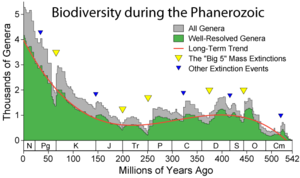I hope the Author will forgive this tangent into evolution.
Johannhowitzer you were right up until the word evolution.
First ParagraphEvolution: Evolution is whenever the allele frequencies of a population change. This can happen due to, Mutation, Natural Selection, Genetic Drift (random mating does not necessitate representative offspring) and Gene Flow (migration).
Mutations are not entirely random. Certain mutations occur more frequently than others. However this is not too important of a point.
Natural Selection describes when a heritable trait (genetic cause) provides a relative reproductive advantage (more viable offspring is a good measurement) it will tend to be more frequent is future generations as long as it provides a relative reproductive advantage. This can be broken down into: Tendency to survive to reproductive age, ability to find/obtain a mate, ability to produce fertile offspring that survive. Natural selection is only partly about survival. Also this gets more complicated because it is actually the genes that are competing not the organisms. Basically you genes count each of your sibling's (you share 50% of your genes with your sibling) offspring as half of one of your offspring.
Genetic Drift is when the random sampling or chance causes the allele frequencies to change. In the below table you see the probability matric of 2 heterozygotes. If a perfect sampling occured then the allele frequencies would not change. However if the sampling was not perfect (say 2 BB, 1 Bb and 1 bb) then the gene frequencies would have obviously changed.
The other common form of Genetic Drift is if a non discriminating event like a natural disaster does not destroy a proportionate sampling. (take the 2BB, 1Bb and 1bb above. if a tornado kills a BB then the gene frequencies would have changed again.) Genetic Drift is very important because it is the major cause of evolution despite not having as large an impact on adaption.
Mutation + Genetic Drift actually gives us a nice interaction. The number of mutations that enter a population is proportional to the size of the population however the chance each has of reaching fixation (100% frequency) is inversely proportional to the number of different mutations for that allele. This means that the rate populations gain new fixed mutations is a constant that can be used to determine roughly how long ago common ancestors would have been.
Finally there is Gene Flow. This is simply migration. If a member is added or subtracted from the group it can change the allele frequencies.
TLDR: Evolution is not just Natural Selection + Mutation
Second ParagraphSophistication has happened sometimes and not others. It is not a necessary result of evolution unlike the previous biological theories that claimed there was a ladder of life moving toward perfect. Evolution does not move toward perfect, sophistication nor even necessarily adaptation (if the other 3 forces are stronger than natural selection in that case).
Neutral mutations occur most often, then negative then positive. However there are a few things to note about genetic disorders especially in the human population.
1)Natural Selection and Mutation form an equilibrium the value of which depends on the population's mutation rate (see Genetic Drift + Mutation) and the Strength of selection on that trait. This equilibrium is at the total allele frequency for negative mutations that Natural Selection removes them at the same rate as Mutation adds them.
2)Natural Selection does not affect non reproducing individuals. This is why we have so many genetic disorders only appear after the end of reproductive age.
TLDR: Evolution does not improve creatures just changes them. All negative mutations relevant to Natural Selection are kept at a equilibrium frequency.
Third ParagraphSpecies tend to become specialized. When the variance of a species drops due to specialization their risk of extinction (if the environment changes) increases. Throughout history there is documented evidence of extinction and even mass extinctions. Extinctions occur whenever the environment changes enough that a species does not adapt before they die out. Indeed there is a fairly constant background extinction rate before humans became a major contributor.

Apparent marine fossil diversity during the Phanerozoic
-http://en.wikipedia.org/wiki/Biodiversity
TLDR: Prior to major human contribution in extinction, biodiversity did increase despite a background extinction rate.

